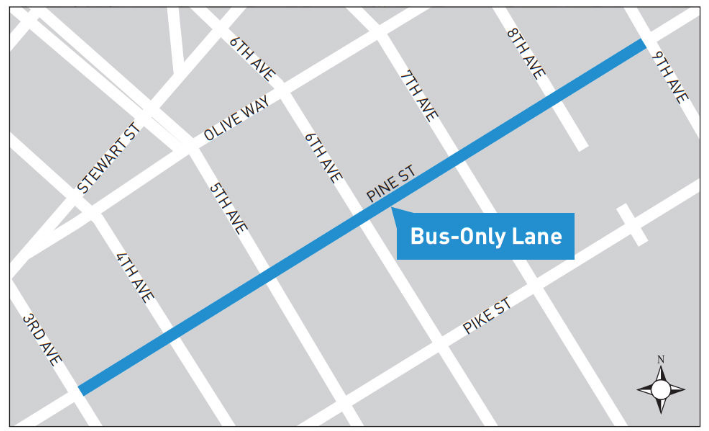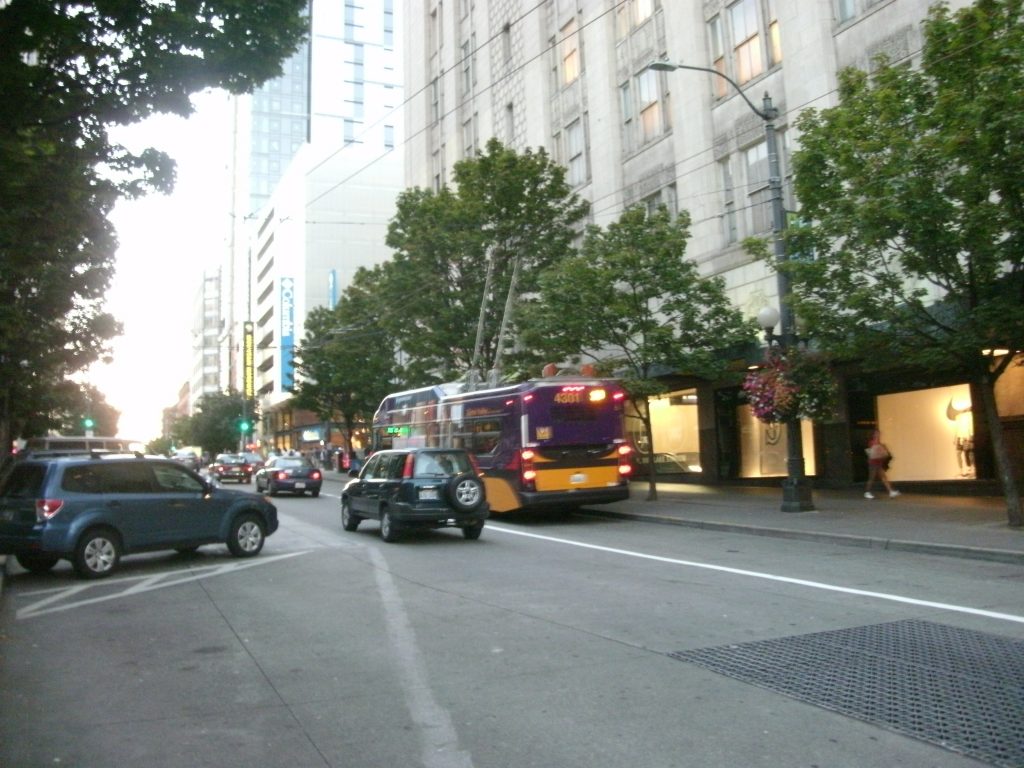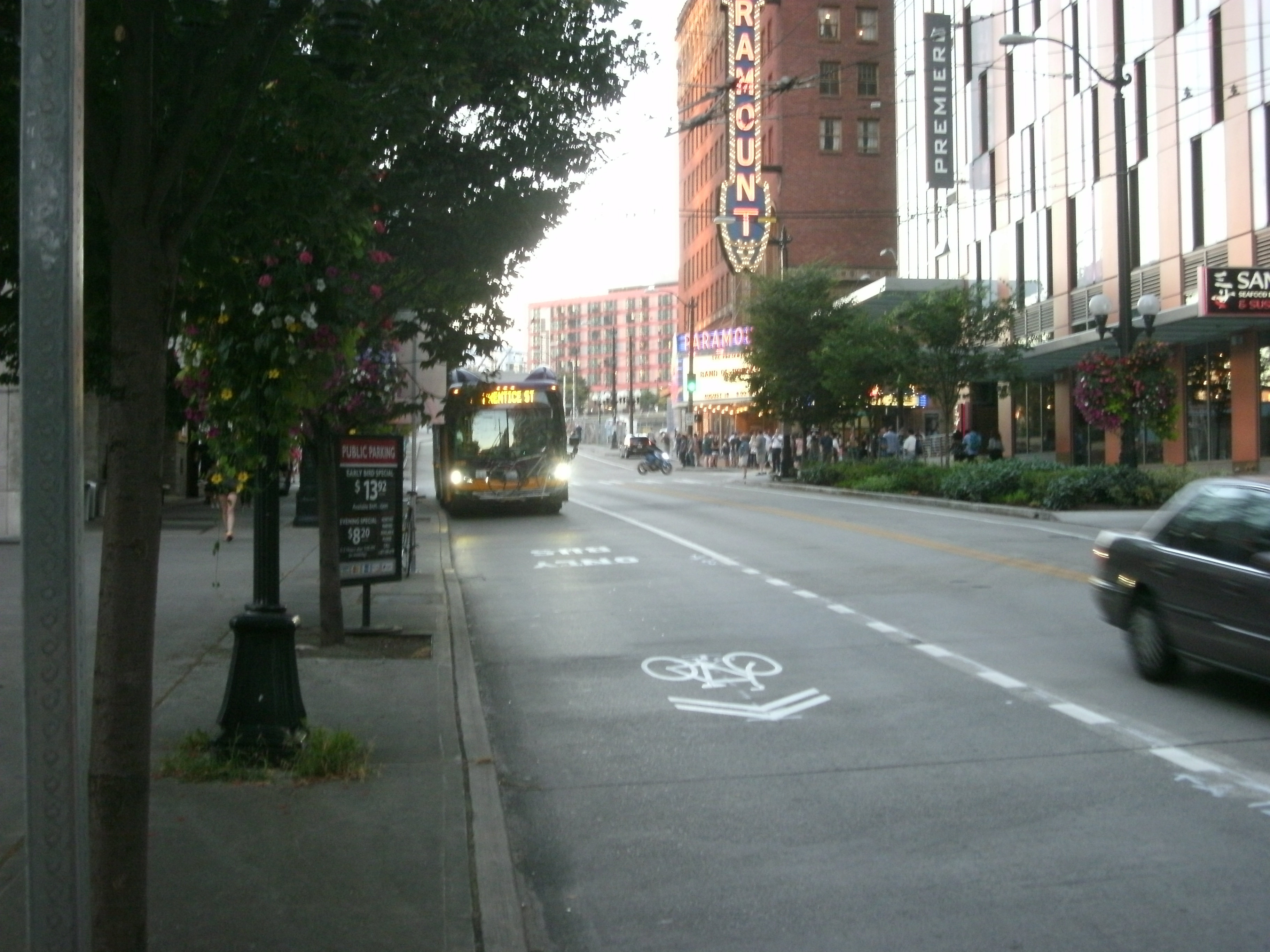The Seattle Department of Transportation (SDOT) has implemented a change on Pine Street this week that we first wrote about back in October. The northern, right-hand lane of the one-way westbound Pine Street from 9th Avenue to 3rd Avenue is now stenciled bus only, and large signs indicate that the street is only for buses, with bikes being OK.
At most of the intersections, however, other vehicles are still permitted to turn right in the bus lane. Traffic moves faster in the left-hand lane currently, with drivers not keen to wait behind deboarding buses at 9th Avenue, 5th Avenue, or 3rd Avenue. So in essence this bus-only lane really only reinforces the current uses of the street.
Bus Lane Concept Map
SDOT’s concept map for the street shows a continuous bus lane between 9th Avenue and 3rd Avenue, but a notable exception to this is the block between 5th and 4th Avenues, which has no painted lane or signage. From the concept study by DKS Associates: “It is assumed buses will move out of this lane because there is a consistent right turn queue.” In other words, the status quo remains on this block, which is absolutely the biggest bottleneck of the corridor, with tons of traffic turning onto Interstate 4 (as I like to call 4th Avenue). The study also predicted that buses will not stay in the bus-only lane between 7th Avenue and 6th Avenue despite the painted lanes, again due to high turn traffic. Once again, this is currently the behavior of the traffic in the street now. Despite the new infrastructure, we are not modeling new behavior, particularly where it would matter most.

As far as the other intersections, the study estimated the time savings to vary from 2.5 seconds (at 9th), 2.2 seconds (at 8th), 3.4 seconds (at 7th), and 7.2 seconds (at 3rd). Notable, however, is the fact that the traffic model specifically took out any turning traffic at 3rd Avenue (“There are very few right turn vehicles so the volume was reduced to the count of buses that would use the lane”).

Bikes on the Corridor
Pine Street is heavily used by people on bikes coming from Capitol Hill to get either north or south Downtown. Currently there is only a bike lane that disappears a half block west of Melrose Avenue, only to reappear after cyclists have to navigate between a right turn lane and a through lane at Boren Avenue, and then disappear again. Protected bike lanes on either Pike or Pine Streets as a way to travel east/west safely have been discussed for years. Any such possibility is locked up in the One Center City Plan (aka Center City Mobility Plan) and so remains a far-off prospect. So people on bikes are left with the status quo, which is essentially the same as it is for buses: the bus-only lane, which is OK for bikes too, will mostly be available, except when it’s heavily used by cars turning right, in which case get ready to switch lanes.
Let’s Talk Vision Zero
We’ve already established that the new design and signage cement the status quo of motorists turning in the bus lanes, which render the bus lanes useless at times and require the bus to maneuver into the other lane. But what about the impact on pedestrians? At none of these intersections is right turn on red restricted, so the turn only lanes are a de facto encouragement to do so. At none of these intersections is there a dedicated pedestrian phase, either, meaning that pedestrians are generally subject to vehicles turning in the crosswalk in at least one direction.
In 2015, six pedestrians were injured on the stretch of Pine Street between 9th and 3rd Avenues, and three people on bicycles. So far in 2016, one person on a bike has been injured and three people walking have been.
At this point, this project appears to be little more than a transit placebo. Time will tell if SDOT is able to implement more broad changes that truly benefit transit riders and improve pedestrian safety at the same time. People using Pine Street could certainly use the help.
Ryan Packer has been writing for The Urbanist since 2015, and currently reports full-time as Contributing Editor. Their beats are transportation, land use, public space, traffic safety, and obscure community meetings. Packer has also reported for other regional outlets including BikePortland, Seattle Met, and PubliCola. They live in the Capitol Hill neighborhood of Seattle.


